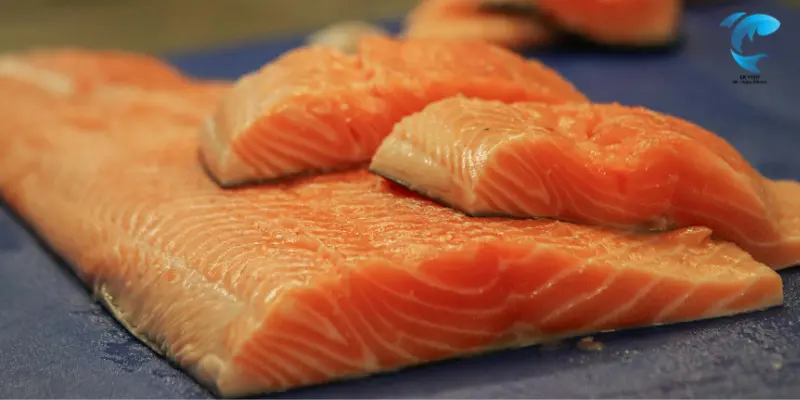Are Speckled Trout Good to Eat? Delicious & Nutritious Guide
Published: 15 Apr 2025
Many are unsure whether speckled trout is a good option when choosing fish for your meals. Concerns about taste, nutritional value, and how to prepare it often leave people second-guessing their choice. This hesitation can lead to missed opportunities to enjoy delicious and healthy fish.
In this article, we’ll address these concerns and provide you with everything you need to know about speckled trout, from its taste to its health benefits.

Are Speckled Trout Good to Eat? Taste Profile & Texture: A Culinary Delight
Flavor Characteristics
Speckled trout has a mild, delicate flavor, making it an appealing choice for those wondering if it is good to eat. Its taste is:
- Mild and clean, without a strong fishy flavor
- Slightly sweet with subtle natural flavors
- Versatile enough to pair with various seasonings and sauces
Originating from clean, clear waters and grass flats, speckled trout’s taste is influenced by its pristine environment and natural diet, giving it a unique and enjoyable flavor profile.
Texture Profile
The texture of speckled trout further solidifies its place as a favorite among seafood lovers:
- Moderate-flaky white meat
- Tender and moist when properly cooked
- Softer than many other inshore fish species
- Delicate structure requiring careful cooking
Its texture is softer than that of other inshore fish, which means it must be cooked gently to avoid becoming mushy. Thus, it is a delicate dish to prepare correctly.
Comparison to Other Fish
When compared to other popular fish species:
- vs. Redfish: Speckled trout has more delicate, white flesh that excels when fried, while redfish offers more versatility in cooking methods like blackening and grilling “on the half shell,” Captain Experiences.
- vs. White Trout: While similar in appearance, speckled trout typically has a slightly more refined flavor profile, though both make excellent table fare.
- vs. True Trout: Unlike rainbow or brook trout (which are salmonids), speckled trout has a less oily texture and milder flavor, with white rather than pink flesh.
Are Speckled Trout Good to Eat? Nutritional Profile: Health Benefits
Macronutrient Composition
Their impressive nutritional profile certainly makes them a healthy option when considering whether they are speckled trout good to eat. Here’s a look at what speckled trout offers:
- Protein: About 23g per 3-ounce serving, providing complete protein with all essential amino acids.
- Calories: Relatively low, at approximately 162 calories per 3-ounce serving.
- Fat: Contains around 6.8g of fat per 3-ounce serving, with much of it being heart-healthy unsaturated fat.
Vitamins and Minerals
Speckled trout is a nutrient-packed fish offering a range of vitamins and minerals that support overall health:
- Vitamins: Rich in B vitamins such as niacin (28% RDA), riboflavin (25% RDA), and thiamin (29% RDA).
- Vitamin D: Provides about 39% of the RDA, which helps maintain strong bones and supports immune function.
- Minerals: Includes potassium, phosphorus (35% RDA), magnesium, and iron (19% RDA).
- Iodine: A great source of iodine, essential for thyroid function.
Omega-3 Fatty Acids
Though specific data for speckled trout’s omega-3 content may not be widely published, as a marine fish, it likely contains beneficial omega-3 fatty acids (EPA and DHA). These fatty acids are known for their numerous health benefits, including:
- Supporting cardiovascular health by reducing inflammation
- Helping lower blood pressure and heart rate
- Decreasing triglyceride levels
- Potentially slowing the progression of atherosclerotic plaque
- Supporting brain function and development
These nutritional attributes solidify speckled trout as not just tasty but also an excellent choice for anyone asking, “Are speckled trout good to eat?“

Health Considerations: Safety & Mercury
Mercury Content
Good news for speckled trout enthusiasts: speckled trout (spotted seatrout) is classified as a LOW mercury fish by the North Carolina Department of Health and Human Services, making it a safe option for regular consumption North Carolina Department of Health and Human Services.
Consumption Recommendations
Based on its classification as a low-mercury fish, consumption guidelines are as follows:
- For women of childbearing age (15-44), pregnant women, nursing mothers, and children under 15: Up to 2 meals per week from the LOW mercury fish list (which includes speckled trout).
- For all other individuals: Up to 4 meals per week from the LOW mercury list.
According to the North Carolina Department of Health and Human Services, these guidelines ensure you can enjoy speckled trout regularly while minimizing any potential health risks.
Cleaning & Preparing Speckled Trout
Essential Tools
To properly clean speckled trout, you’ll need:
- A sharp, well-honed filleting knife
- A Flex blade for separating the file
- sh from the skin
- A clean, stable cutting surface
- Ice to keep the fish fresh during cleaning Louisiana Sportsman
Step-by-Step Cleaning Instructions
Follow these seven steps to clean speckled trout efficiently:
- With the knife’s cutting edge turned toward the tail, insert the knife just below and slightly behind the pectoral fin.
- Smoothly extend the knife through the length of the gut cavity to near the anal vent.
- Lay the fish on its side and make a vertical cut to the backbone behind the head.
- Turn the knife blade to face the tail and, keeping close to the backbone, cut down the length of the fish to separate the fillet from the carcass.
- Remove the fillet and set it aside. Edges should be smooth and straight (ragged edges indicate a dull knife).
- Turn the fish over and repeat the filleting process on the other side. Then, cut out and discard the rib cage.
- Pinch the fillet skin-side down on your cutting surface, and use a Flex blade to scrape the flesh from the skin of Louisiana Sportsman gently.

Storage Tips
Due to its delicate texture, speckled trout requires proper handling:
- Keep freshly caught trout on ice immediately.
- Clean as soon as possible after catching.
- Trout does not freeze like other fish, so enjoying fresh is best.
- If freezing is necessary, vacuum sealing helps maintain quality.
Delicious Speckled Trout Recipes
Classic Pan-Seared Trout with Garlic Lemon Butter

| Ingredients |
|---|
|
| Directions |
|---|
|
Speckled Trout in Capers and White Wine

| Ingredients |
|---|
|
| Directions |
|---|
|
Speckled Trout Fish Piccata

| Ingredients |
|---|
|
| Directions |
|---|
|
Grilled Whole Speckled Trout
| Ingredients |
|---|
|
| Directions |
|---|
|
Conclusion: A Seafood Treasure
In conclusion, speckled trout truly lives up to its reputation as an excellent eating fish. Its mild, delicate flavor, flaky texture, and impressive nutritional profile make it a perfect choice for culinary enjoyment and health benefits. Whether you are an experienced angler bringing home your catch or a seafood enthusiast choosing from the market, speckled trout is a versatile, nutritious, and delicious option for your next meal.
Classified as a low-mercury fish, speckled trout is safe for regular consumption, allowing you to savor its rich protein, vitamins, minerals, and omega-3 content without worry.
Speckled trout stands out in various preparations, from a simple pan-sear with garlic lemon butter to a flavorful baked dish or a zesty piccata. Cook it carefully to preserve its delicate texture, and enjoy it fresh for the best experience.
Next time you’re deciding on a seafood dish, consider speckled trout. Your taste buds and body will appreciate this healthy and flavorful coastal delight.
FAQs
Speckled trout boasts a unique, mild, sweet flavor with a tender, flaky texture. Its white, slightly firm meat is not overly greasy, making it a versatile option for grilling, frying, or baking. The taste, often likened to other popular fish like redfish or flounder, is not too fishy, appealing to a wide range of palates and piquing the interest of seafood enthusiasts.
Indeed, speckled trout is a healthy choice. It’s low in fat and calories and a rich source of essential nutrients, including protein, omega-3 fatty acids, and vitamin B12. These omega-3s are known to reduce inflammation, improve heart health, and support brain function, making speckled trout a reassuring choice for those seeking a nutritious, heart-healthy meal.
While speckled trout can be a delightful addition to your raw dishes if fresh and adequately handled, it’s crucial to source it from a reputable supplier. This caution is necessary to minimize any risk of parasites or bacteria, ensuring a safe and enjoyable dining experience.
Speckled trout is highly versatile and can be prepared in various ways. Popular cooking methods include grilling, frying, baking, and broiling. For grilling, marinate the fish with herbs and citrus before cooking. Frying is another favorite method, often with a light batter or seasoning. Speckled trout also pairs well with light sauces or fresh herbs, enhancing its delicate flavor.
While speckled trout is generally safe and nutritious, it is essential to be mindful of the potential for mercury accumulation in particular fish species. However, speckled trout typically contain lower mercury levels than larger predator fish. If you are pregnant or breastfeeding, it’s always best to consult with a healthcare professional before consuming fish to ensure it aligns with dietary recommendations for safety.

SK Fish is your trusted source for practical fish care tips and delicious seafood recipes. Our team is dedicated to providing reliable, well-researched content for fishing enthusiasts and home cooks alike.

- Be Respectful
- Stay Relevant
- Stay Positive
- True Feedback
- Encourage Discussion
- Avoid Spamming
- No Fake News
- Don't Copy-Paste
- No Personal Attacks



- Be Respectful
- Stay Relevant
- Stay Positive
- True Feedback
- Encourage Discussion
- Avoid Spamming
- No Fake News
- Don't Copy-Paste
- No Personal Attacks





